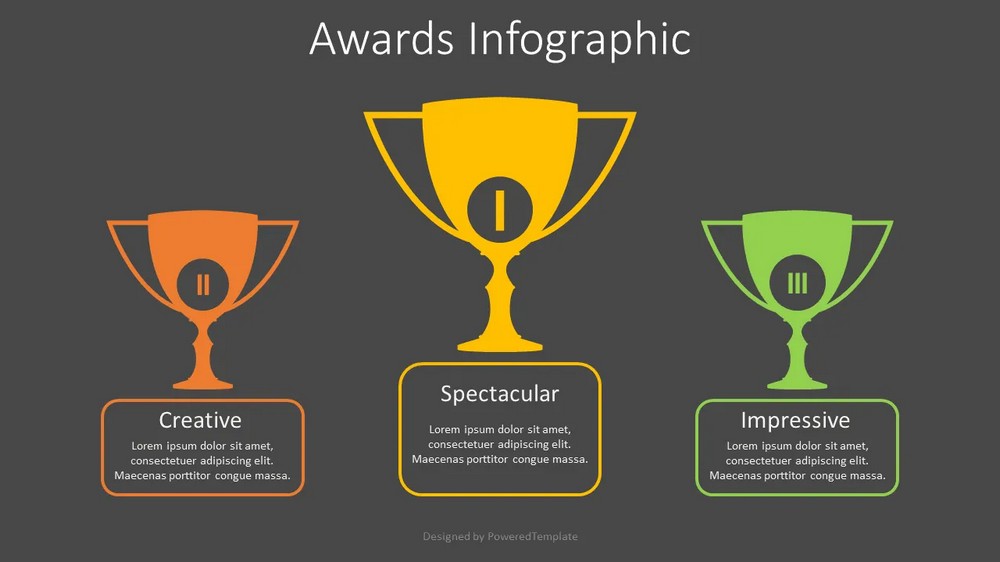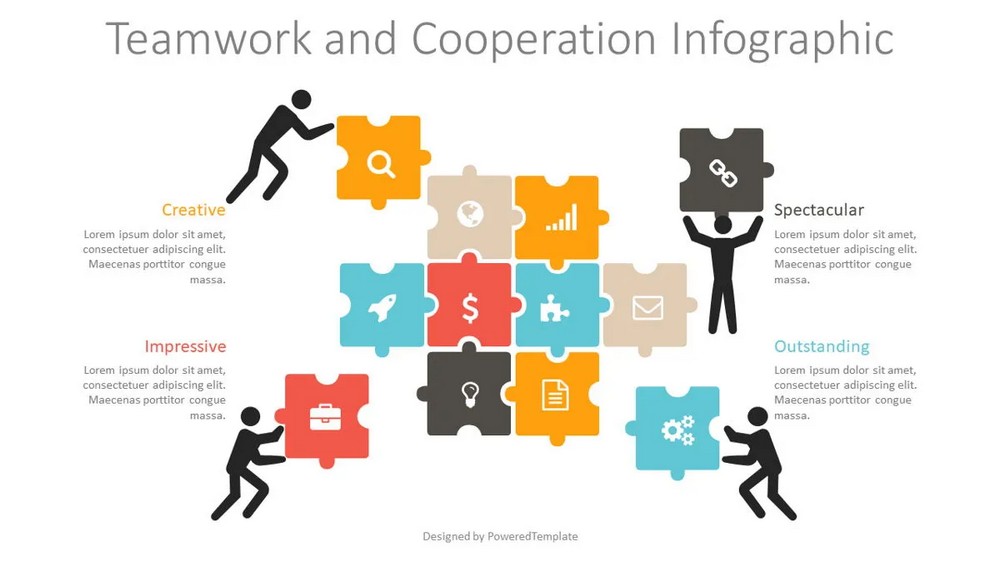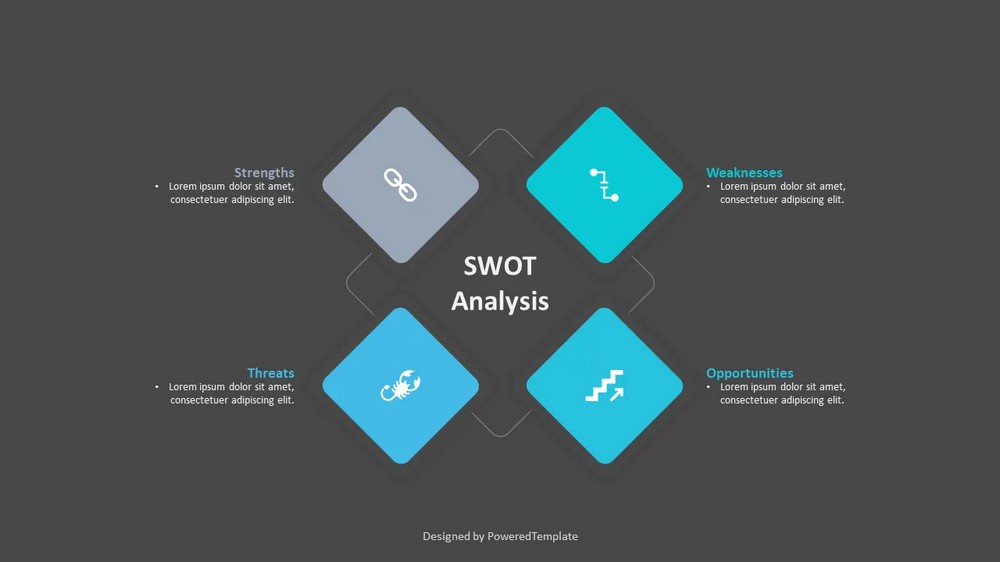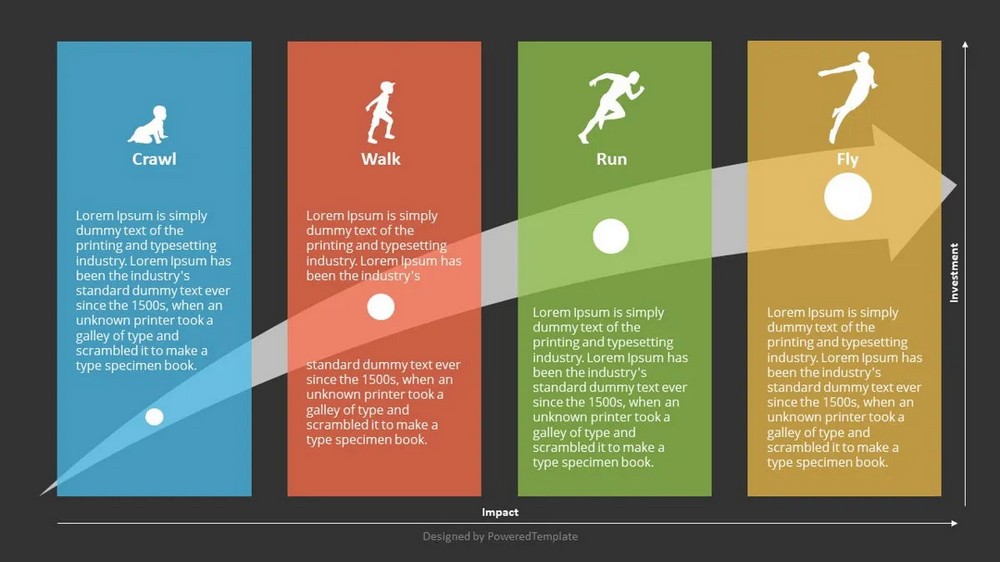This article explores the significance of strategic planning in business management and provides a step-by-step guide to implementing an effective strategic plan. It highlights the benefits of strategic planning, defines key concepts, and discusses the components involved in the process. The article also addresses common challenges in strategic planning and offers best practices to overcome them.
With this text, we are launching a series of eight articles dedicated to business management.
This article includes a selection of presentation templates available in the PoweredTemplate library, which are specifically designed to complement the topic of strategic planning in business management. They serve as visual aids to effectively demonstrate essential concepts and ideas associated with strategic planning. These templates offer a valuable resource for business professionals aiming to enhance their presentations and skillfully communicate the significance of strategic planning to their teams and stakeholders.
Table of Contents
- Importance of Strategic Planning in Business Management
- Understanding Strategic Planning in Business Management
- Step-by-Step Guide to Strategic Planning
- Overcoming Challenges in Strategic Planning
- Best Practices in Strategic Planning
- Conclusion
Importance of Strategic Planning in Business Management
Strategic planning holds immense significance in effective business management. In this section, we delve into why strategic planning is a vital practice that can greatly impact the success and growth of an organization.
Successful businesses recognize the need to have a clear direction and a roadmap to guide their actions. Strategic planning provides that roadmap by defining the organization’s vision, mission, and long-term goals. It helps align all departments and stakeholders towards a common purpose, fostering unity and synergy within the organization.

One of the primary advantages of strategic planning is its ability to enhance decision-making. By conducting a comprehensive analysis of the internal and external factors that influence the business, strategic planning enables leaders to make informed choices based on a solid understanding of the current landscape. This minimizes the risk of making hasty decisions and allows for more thoughtful and calculated actions.
Strategic planning also aids in resource allocation. By assessing the organization’s strengths, weaknesses, opportunities, and threats, businesses can allocate their resources more effectively. This includes financial resources, human capital, and other assets, ensuring that they are utilized in the areas that align with the organization’s strategic priorities.
Furthermore, strategic planning provides a framework for anticipating and adapting to changes in the business environment. With rapid technological advancements, shifting customer demands, and evolving market trends, businesses need to be agile and responsive. Strategic planning allows organizations to identify emerging trends, capitalize on opportunities, and mitigate potential risks.

In addition to these benefits, strategic planning enhances communication and collaboration within the organization. It provides a platform for sharing the strategic vision with employees, fostering a sense of purpose and alignment. When everyone understands and embraces the organization’s strategic goals, it creates a cohesive and motivated workforce that works towards achieving those goals.
In summary, strategic planning is of utmost importance in business management. It establishes a clear direction, aids in decision-making, optimizes resource allocation, enables adaptation to a dynamic environment, and fosters effective communication and collaboration. Businesses that prioritize strategic planning are better positioned to achieve sustainable growth, maintain a competitive edge, and navigate the complexities of the ever-changing business landscape.
Understanding Strategic Planning in Business Management
Strategic planning in business management is a comprehensive process that organizations undertake to define their long-term goals and develop a roadmap to achieve them. It involves analyzing the internal and external factors that affect the business, setting objectives, and formulating strategies to attain those objectives.
Definition and Key Concepts
At its core, strategic planning involves aligning an organization’s resources, capabilities, and actions with its mission, vision, and values. It provides a structured approach to guide decision-making and resource allocation, ensuring that every effort contributes to the overall strategic direction.

Key concepts within strategic planning include:
- Mission: The purpose or reason for an organization’s existence. It defines the organization’s scope and primary objectives, reflecting its core values and aspirations.
- Vision: A desired future state or outcome that the organization strives to achieve. The vision provides a clear picture of what the organization aims to become and serves as a source of inspiration and motivation.
- Goals and Objectives: Specific targets or milestones that the organization aims to accomplish within a defined timeframe. Goals are typically broader in nature, while objectives are more specific and measurable.
- SWOT Analysis: An assessment of the organization’s internal strengths and weaknesses, as well as external opportunities and threats. SWOT analysis helps identify strategic advantages, areas for improvement, and potential risks that need to be addressed.

Benefits of Strategic Planning in Business Management
Strategic planning offers several benefits to businesses in their management and growth endeavors. These benefits include:
- Direction and Focus: Strategic planning provides a clear sense of direction, ensuring that all activities and decisions align with the organization’s long-term goals. It helps prioritize efforts, allocate resources effectively, and avoid distractions.
- Enhanced Decision-Making: With a strategic plan in place, decision-makers have a framework to evaluate choices against the organization’s strategic objectives. This leads to more informed and consistent decision-making, reducing the likelihood of pursuing conflicting or counterproductive initiatives.
- Improved Resource Allocation: By understanding the organization’s strategic priorities, strategic planning enables businesses to allocate resources in a way that optimally supports those priorities. This ensures that resources, including financial, human, and technological, are utilized efficiently and effectively.
- Adaptation to Change: Strategic planning equips businesses with the ability to proactively respond to changes in the external environment. It helps identify emerging trends, anticipate potential risks, and capitalize on new opportunities, enabling organizations to stay ahead of the curve and remain competitive.

Components of Strategic Planning
Strategic planning comprises various components that work together to develop a comprehensive and effective strategy. These components include:
- Environmental Analysis: This involves assessing the internal and external factors that impact the organization. Internal analysis focuses on the organization’s strengths and weaknesses, while external analysis examines market trends, competition, and other external influences.
- Setting Goals and Objectives: Based on the analysis, organizations define their long-term goals and objectives. These goals should be specific, measurable, achievable, relevant, and time-bound (SMART), providing a clear target for the organization to work towards.
- Strategy Formulation: This stage involves developing strategies and action plans to achieve the defined goals and objectives. It includes determining the most effective approaches, allocating resources, and identifying key performance indicators to track progress.
- Implementation and Execution: Once the strategic plan is formulated, it needs to be effectively implemented throughout the organization. This involves communicating the plan to all stakeholders

Step-by-Step Guide to Strategic Planning
Implementing strategic planning requires a systematic approach to ensure its effectiveness. This step-by-step guide outlines the key stages involved in the strategic planning process, from preparation to evaluation and adaptation.
Preparing for Strategic Planning
Preparing for strategic planning is a crucial initial step that sets the foundation for a successful and effective process of strategic goal setting.

- Establish the Planning Team: Assemble a team of key stakeholders from various departments and levels within the organization. This team will be responsible for leading and facilitating the strategic planning process.
- Define the Scope and Objectives: Clearly outline the scope of the strategic planning effort and establish the objectives to be achieved. This helps focus the planning process and ensures alignment with the organization’s overall mission and vision.
- Gather Information: Collect relevant data and information about the organization, industry trends, market dynamics, customer insights, and competitors. This information serves as the foundation for analysis and decision-making during the strategic planning process.

Analyzing the Current State of the Business
Analyzing the current state of the business is a critical step in the strategic planning process. It involves conducting a thorough assessment of internal and external factors that influence the organization’s performance and shape its strategic direction.
- Conduct a SWOT Analysis: Evaluate the organization’s strengths, weaknesses, opportunities, and threats. This analysis provides a comprehensive understanding of the internal and external factors that impact the business and helps identify areas of competitive advantage and areas for improvement.
- Identify Key Issues and Challenges: Based on the SWOT analysis and other information gathered, identify the critical issues and challenges that need to be addressed through strategic planning. These could include market shifts, operational inefficiencies, emerging technologies, or changes in customer preferences.
Developing the Strategic Plan
Developing the strategic plan involves translating the organization’s vision, goals, and objectives into actionable strategies and initiatives. The strategic plan provides a roadmap for the organization’s future success and serves as a valuable tool for decision-making and resource allocation.
- Define the Vision and Mission: Clearly articulate the desired future state of the organization (vision) and its purpose and reason for existence (mission). These statements provide a guiding framework for the strategic plan.
- Set Goals and Objectives: Establish specific, measurable, achievable, relevant, and time-bound (SMART) goals and objectives that align with the organization’s vision and mission. These goals should be challenging yet attainable and should reflect the desired outcomes of the strategic plan.
- Formulate Strategies: Develop strategies that outline the overarching approaches and initiatives to achieve the defined goals and objectives. Consider different strategic options, evaluate their feasibility, and select the most appropriate strategies for implementation.
Implementing the Strategic Plan
Implementing the strategic plan involves translating the defined strategies into action. By effectively implementing the strategic plan, organizations can transform their vision into reality. The implementation phase requires clear communication, resource allocation, collaboration, monitoring, and a culture of adaptability. Continuous evaluation and refinement ensure that the strategic plan remains relevant and effective in a dynamic business environment.

- Communicate the Plan: Clearly communicate the strategic plan to all stakeholders within the organization. This includes employees, management, and other relevant parties. Ensure that everyone understands the plan’s goals, objectives, strategies, and their respective roles and responsibilities.
- Allocate Resources: Allocate the necessary resources, including financial, human, and technological, to support the implementation of the strategic plan. Ensure that resources are distributed effectively and in alignment with the priorities identified in the plan.
- Establish Action Plans: Develop detailed action plans that outline the specific activities, timelines, and responsible parties for implementing each strategy. Break down the strategic goals into actionable steps to facilitate efficient execution.
Evaluating and Adapting the Strategic Plan
By regularly evaluating and adapting the strategic plan, organizations can ensure its relevance, effectiveness, and ability to drive desired outcomes. This ongoing process allows for flexibility and agility in response to internal and external changes, ultimately leading to sustained success.

- Monitor Progress: Regularly monitor the progress of the strategic plan implementation. Track key performance indicators (KPIs) and milestones to assess whether the organization is on track to achieve its goals and objectives.
- Evaluate Results: Conduct periodic evaluations to assess the effectiveness
Overcoming Challenges in Strategic Planning
Strategic planning in business management comes with its fair share of challenges. It is essential for organizations to anticipate and address these obstacles to ensure the successful execution of their strategic plans. This section explores some common challenges encountered in strategic planning and provides strategies to overcome them.

- Lack of Alignment and Engagement:
- Challenge: One of the challenges in strategic planning is ensuring alignment and engagement from stakeholders across the organization. When there is a lack of alignment, it becomes difficult to achieve a unified vision and collective effort towards the strategic objectives.
- Strategy: Foster a culture of collaboration and open communication within the organization. Encourage active participation and engagement from all stakeholders, emphasizing the importance of strategic planning in achieving business management goals. This can be done through regular meetings, workshops, and feedback sessions where strategic planning discussions take place.
- Insufficient Resources and Budget:
- Challenge: Limited resources, including financial and human resources, can pose a significant challenge in implementing strategic plans effectively. Without adequate resources, it becomes difficult to execute key initiatives and allocate necessary investments.
- Strategy: Optimize resource allocation by prioritizing strategic initiatives that align with business management objectives. Make a compelling case to secure additional resources or reallocate existing resources to support the strategic plan. It is crucial to communicate the potential return on investment and the long-term benefits of allocating resources to strategic initiatives.
- Uncertain External Environment:
- Challenge: The external business environment is often dynamic and unpredictable, presenting challenges in strategic planning. Factors such as market fluctuations, regulatory changes, or technological advancements can impact the effectiveness of strategic initiatives.
- Strategy: Continuously monitor the external environment and stay updated on industry trends and developments. Build flexibility into the strategic plan to accommodate unforeseen changes and adapt to emerging opportunities. Regularly evaluate the plan’s alignment with the evolving external landscape and make adjustments accordingly.
- Resistance to Change:
- Challenge: Resistance to change is a common challenge in strategic planning and business management. Employees and stakeholders may resist new strategies, processes, or organizational changes due to fear of the unknown or concerns about their roles and responsibilities.
- Strategy: Foster a culture of change readiness and resilience within the organization. Clearly communicate the rationale behind the strategic plan and how it aligns with the organization’s vision and goals. Involve employees in the planning process, provide them with the necessary training and support, and address their concerns proactively. Encourage open dialogue and create channels for feedback to mitigate resistance and promote a smooth transition.
- Ineffective Communication and Alignment:
- Challenge: Poor communication and lack of alignment can hinder the successful implementation of strategic plans. When communication is ineffective, it leads to misunderstandings, misinterpretations, and misalignment of efforts within the organization.
- Strategy: Establish clear and transparent communication channels for sharing strategic objectives, progress updates, and expectations. Emphasize the importance of effective communication in driving business management success. Ensure that the strategic plan is consistently communicated to all levels of the organization, and encourage feedback and questions to foster alignment and understanding.

By proactively addressing these challenges, organizations can enhance the effectiveness of their strategic planning and business management efforts. Remember, strategic planning is an iterative process that requires ongoing evaluation, adaptation, and continuous improvement to drive success.
Best Practices in Strategic Planning
Implementing best practices in strategic planning is crucial for organizations to maximize the effectiveness and success of their strategic initiatives. By incorporating best practices we exploring below into the strategic planning process, organizations can enhance their ability to achieve their business management goals. Remember, strategic planning is not a one-size-fits-all approach, and organizations should tailor these practices to their specific needs and circumstances. The continuous application of these best practices fosters a culture of excellence and supports long-term success.
- Engaging Stakeholders Throughout the Process:
- Engage stakeholders from various levels and departments in the strategic planning process. Seek their input, perspectives, and expertise to foster a sense of ownership and commitment. By involving stakeholders, organizations can benefit from diverse insights and ensure alignment between strategic objectives and operational activities. This inclusive approach promotes collaboration and creates a shared understanding of the strategic plan.
- Incorporating Flexibility and Adaptability:
- Embrace the dynamic nature of the business environment by building flexibility and adaptability into the strategic planning process. Recognize that plans may need to be adjusted in response to changing market conditions, emerging opportunities, or unforeseen challenges. By being agile and open to adjustments, organizations can stay responsive and proactive in achieving their business management goals.
- Aligning Strategic Goals with Operational Activities:
- Ensure that the strategic goals set during the planning phase are effectively translated into actionable operational activities. Establish clear linkages between the strategic plan and day-to-day operations, performance metrics, and resource allocation. This alignment helps drive consistency, accountability, and progress towards strategic objectives throughout the organization.
- Regularly Reviewing and Updating the Plan:
- Strategic planning is not a one-time event but an ongoing process. Regularly review the strategic plan to assess its progress and relevance. Set up mechanisms for monitoring key performance indicators and milestones to track the implementation of the plan. Conduct periodic reviews to evaluate the effectiveness of the strategies and make necessary adjustments. This iterative approach ensures that the strategic plan remains responsive to changing business dynamics.
- Building a Culture of Strategic Thinking:
- Foster a culture that values strategic thinking and encourages employees at all levels to contribute to the organization’s strategic goals. Provide training and development opportunities to enhance employees’ strategic capabilities. Promote a mindset of continuous improvement, innovation, and forward-thinking. By embedding strategic thinking into the organizational culture, organizations can cultivate a proactive and adaptive approach to business management.
Conclusion
In conclusion, strategic planning plays a vital role in business management, driving success and growth. It enables organizations to navigate the complex business landscape, make informed decisions, and achieve their long-term objectives. By embracing strategic planning as an integral part of business management, organizations can navigate uncertainties, seize opportunities, and unlock success in today’s competitive landscape.




